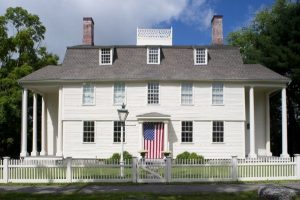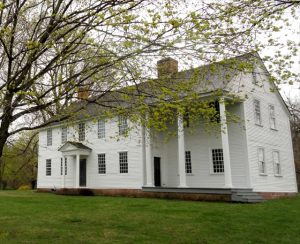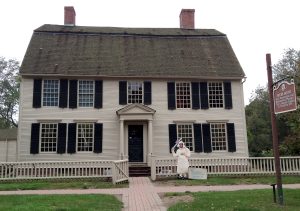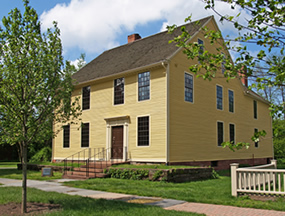“Connecticut: Still Revolutionary,” is the official slogan of Connecticut’s tourism program since about 2014. As a historian who worked in architecture as the son of an architect, I have often been fascinated by the wealth of historic homes still standing in Connecticut. There are hundreds upon hundreds from the eighteenth century, among which a handful stand out for a myriad of reasons. To pick the top ten Patriot homes, I based my selections on the scale and ornate woodwork of the home, the historical significance of the owner, the historical significance of its visitors, and in some cases, the historical significance of the designer or builder. I did not include homes of Loyalists, or public buildings such as Yale’s Connecticut Hall or Congregational Churches. I also did not include homes no longer standing. Rather than to rank them, which would be difficult, I chose to list them by their location, which in several cases includes homes from the same historic town.
The Governors Jonathan Trumbull Senior and Junior Homes, Lebanon
The homes of Governors Jonathan Trumbull Senior and Junior, which are located across the green from each other in Lebanon, are worthy of inclusion because of the importance of their owners. Jonathan Senior was the only governor of any of the thirteen colonies who served in his role before, during and after the American Revolution. Not only did Trumbull Sr. host Gen. George Washington, he also hosted the French military leadership, including both the Comte de Rochambeau and the Duc de Lauzun during their visits to Connecticut later in the war, which puts the houses and the town of Lebanon on the W3R Trail. Jonathan Junior was not only briefly an aide to Washington during the Yorktown Campaign of 1781, he also kept of diary of that campaign, and later served as governor of Connecticut. Both Senior and Junior, of course, were painted by their famous son/brother, John, who has no home from his adult days still standing, and who is buried at Yale. The Lebanon town green is arguably the largest in all of New England, likely second only to the Boston Common, so the quaint, remote farming town has a lot to boast. Both of the Trumbull houses are open to the public as museums, with the Senior house owned by the CTDAR (Daughters of the American Revolution). Visit: www.facebook.com/JTrumbullJr.Museum and www.govtrumbullhousedar.org

Governor Oliver Wolcott House, Litchfield
Oliver Wolcott is not a household name, but this unsung Founding Father of Connecticut was a signer of the Declaration of Independence as well as the Articles of Confederation. He also served as a representative of Connecticut and the state’s nineteenth governor. He was a major general in the Connecticut militia during the Revolutionary War. His white, wood clapboard colonial built in 1753 on South Street in Litchfield may not be open to the public, but it was recognized for its owner’s significance when it was added in 1971 as a National Historic Landmark. Wolcott’s grave is down the hill from the house, not far from Benjamin Tallmadge’s grave. Both Lafayette and Washington stayed at this house during their visit to Litchfield in September of 1780 on their way to or from their conference with the French general Comte de Rochambeau in Hartford.

Major Benjamin Tallmadge House, Litchfield
This house was built for Thomas Sheldon in 1775, who must have been related to the Colonel Elisha Sheldon who commanded the 2nd Light Dragoons. That regiment’s most famous officer was Maj. Benjamin Tallmadge, who could have been famous for his heroic deeds during the Battles of New York as well as raids on Long Island, but is of course best known as the case officer of the famous Culper Spy Ring. While Tallamage rented a home in Wethersfield as a bachelor during the war, once fighting slowed down in 1782 he married Mary Floyd, daughter of Declaration signer William Floyd (who still has two homes standing in New York State). Tallmadge’s house was modified during his ownership with the addition of a front portico and two side porches with columns reminiscent of the porch at the Ellsworth House in Windsor.

Oliver Ellsworth Homestead, Windsor
Also known as Elmwood, the home was built in 1781 as the home of American lawyer and statesman Oliver Ellsworth, where he lived until his death in 1807. It was designated as a National Historic Landmark in the 1970s and is owned by the CTDAR as a museum open to the public. The house has an unusual side gabled porch supported by Tuscan columns. The name Elmwood derives from the thirteen elm trees Ellsworth planted in his yard. Presidents Washington and Adams visited this estate in 1789 and 1799, respectively. Ellsworth gets credit from scholars of the Founding Fathers generation for helping Roger Sherman propose the “Connecticut Compromise,” in which smaller states received equal footing with larger colonies such as New York and Virginia, manifested as the U.S. Senate, while the second, lower body of representatives became known as the House of Representatives. Ellsworth also served as third Chief Justice of the U.S. Supreme Court and received eleven electoral votes in the 1796 presidential election. Visit: ellsworthhomesteaddar.org

General Epaphroditus Champion House, East Haddam
He may not be well known, but his quirky name might stick in your head once you’ve heard it. Champion was a patriot leader born in Colchester, Connecticut born into a locally prominent family, including a brother who served as a major in the Continental Army and later as a representative in Connecticut. Epaphroditus helped his father, Col. Henry Champion, in collecting 300 cattle to drive down to Valley Forge for that fateful, famous winter encampment. Those cattle were devoured by the starving soldiers in just five days. Epaphroditus served an officer in the Connecticut militia after the war, rising from captain in 1784 to lieutenant colonel in 1795 and then brigadier general of the Seventh Brigade from 1800 to 1803. He was also a merchant, shipowner and exporter of goods to the West Indies. What makes the Champion House so noteworthy is who designed and built it. Champion chose the best: William Sprats, a former Hessian soldier who remained in Connecticut after the war, who designed and built three stately houses still standing in the Nutmeg State, including Champion’s, the Old Gate of the Cowles family of Farmington, and the imposing Julius Deming House on North Street in Litchfield, just across the street from the Benjamin Tallmadge House. Along with those two houses, the Champion House features the very finest wood carving seen in any house, including impressive, ornate over-mantel carving in the best parlor and large dental work reminiscent of the finest homes in Newport and Philadelphia. The house is privately owned.

General David Humphreys House, Derby
This charming, quaint house on a busy stretch in the small city of Derby was built in the 1690s, and was the birthplace of Col. David Humphreys, a long-time aide to General Washington, as well as a cavalry officer who led daring whaleboat and cavalry raids in New York state. Owned by the Derby Historical Society, the red, wood-clapboard house with white trim, of a center chimney design, is a stone’s throw from the Housatonic River, and only about ten miles north of the important colonial port city of New Haven. Humphreys was born in this house in 1752. He was nominated by Washington after the American Revolution as the first ambassador of the United States to a foreign country (Portugal). He was also responsible for introducing merino sheep to Connecticut, brought over when he served as U.S. Ambassador to Spain. Humphreys stayed at Washington’s Mount Vernon for over a year after the Revolution, writing America’s first biography by an American, a short book on the colorful life of Gen. Israel Putnam. Visit: www.derbyhistorical.org/humphrey.htm

Joseph Webb House, Wethersfield
This stately house featuring beautiful interior woodwork was built in 1752 for wealthy merchant Joseph Webb. The house is historically significant for hosting General Washington for five nights in May of 1781 while he met with the French General Comte de Rochambeau about the strategy to combine forces to defeat the British, eventually leading to the victory at Yorktown. This famous guest is likely how the house earned its name “Hospitality Hall.” It was also the childhood home of Samuel Blachley Webb, who served as an aide to Washington during the 1776-1777 campaigns and held the Bible at Washington’s inauguration in New York City in 1789. Webb served as regimental commander of his “additional regiment,” or Webb’s 9th Regiment, throughout the war, was wounded three times in battle, and was one of the original members of the Society of the Cincinnati.

Silas Deane House, Wethersfield
Immediately next door to the Webb House is the Deane House, named for Diplomat Silas Deane. Silas first married Joseph Webb’s widow, Mehitabel, in 1763. This helped him become a wealthy merchant who traded with the West Indies in horses, lumber and red onions. Mehitable unfortunately died in 1767, and in 1769, Deane married another rich widow, Elizabeth Saltonstall Evards from New London. She was the granddaughter of a former governor of Connecticut. Deane was an attorney who served in the Connecticut General Assembly and became one of Connecticut’s three delegates to the First Continental Congress in 1774 in Philadelphia. He helped plan and finance the capture of Fort Ticonderoga in May of 1775, in part because of his friendship with fellow wealthy merchant, Benedict Arnold. In the summer of 1776, Deane was in Paris, secretly securing French military supplies for the patriot cause, as well as approving the voluntary services of the Marquis de Lafayette and Baron de Kalb. The house, built in 1761, features an ornate front door and an equally impressive ornate staircase in the front hall, with three different designs for the spindles of the staircase. The best parlor, where General Washington dined in 1775 on his way north to take command of the troops outside of Boston, features an elaborate and rare Portland redstone fireplace mantel, a material generally used for headstones of the period; because of its interior location, the stone remains in perfect condition. The Webb and Deane houses are owned and operated as museums by the Colonial Dames. Visit: webb-deane-stevens.org

General Jedediah Huntington House, Norwich
Jedediah Huntington finished second in his class of 1763 at Harvard, when the Ivy League college ranked graduates based on wealth rather than academic standing, attesting to the assessment that the Huntingtons were the wealthiest family in eastern Connecticut at the outset of the war. Jedediah’s father, Jabez, raised five Patriot sons who helped lead the Revolution, Jabez himself serving as a major general in the Connecticut militia during the war. Jedediah was a leader of the Sons of Liberty and commanded a regiment at the Battle of Ridgefield in 1777, for which he was promoted to brigadier general in the Continental Army. He was loyal, faithful confidant of General Washington, leading the troops from Connecticut at the Valley Forge encampment as well as at the Battle of Monmouth the following summer. He remained with Washington to the end of the war, and was, along with Henry Knox and Baron von Steuben, among the few generals with Washington near Newburgh in late 1783. What makes the Huntington House, built in 1765, especially notable is that it not only hosted the Marquis de Lafayette twice during the war, but also other French officers. Moreover, it was the home of the equally interesting and important younger half-brother of Jedediah, Ebenezer Huntington. Ebenezer inherited the house from Jedediah in 1789 when the older Jed was appointed by Washington to serve as Customs Collector at the port of New London, where he relocated and built the stately “Mount Vernon” that year. Ebenezer not only served as an officer throughout the entire American Revolution, from 1775 to 1783, but also as second in command of Webb’s Additional Regiment, and as de facto commander when Webb was captured during a hapless raid on Long Island in 1777. Ebenezer served in the Yorktown Campaign as second in command of the light infantry regiment under Colonel Alexander Scammell. Ebenezer was an original member of the Society of the Cincinnati in 1783, and served as a brigadier general in the U.S. Army in 1798-99 during the quasi-war with France. It was for this later conflict that Ebenezer was painted by his famous brother-in-law, John Trumbull. This portrait was sold at auction in the spring of 2018 to the Society of the Cincinnati. Ebenezer also served as a Federalist U.S. Congressman, alongside Benjamin Tallmadge, for two terms in the early 1800s.













17 Comments
Nice article! Backstories always make the basic facts so much more interesting.
Enjoyed the article, and it brought back some memories. As a child I would frequently visit the Enfield, Connecticut home of my maternal grandparents, which was built in the 1760’s. I don’t think it was owned by anyone famous during the revolution, but legend was that it was a tavern that had some famous visitors. I won’t however trot out the “Washington slept here” cliche, as I’m not sure he was one of them. And I won’t mention the address, as it’s still privately owned, though my brother and I regarded it as a museum. The low ceilings, uneven floors, quirky floor plan, and many unique period features made it an interesting place to visit, especially for a kid. I wish I could visit it now, but it’s no longer in the family.
Ironically, with all the time I spent in Connecticut, I never visited any of the homes you listed. I wasn’t old enough to appreciate the history, and it was much more fun to have a real life museum we could run around and play in anyway!
Thank you for this feature.
Excellent article! Always enjoy reading them. Actually there’s a few of these ancestors within our family tree … which make even more interesting and to share with our grandchildren.
Thank you
near the Enfield Historical Society’s Old Town Hall Museum.
Thank you for your kind words! I may do a similar article later this year.
Agree, what a great article Sir! JAR is my fav site. I love clapboard and columns, who doesn’t! How interesting that CT has stone walls everywhere, but there and in NY State you hardly ever see stone houses?
I hope that clever charming campaign slogan attracts people from all over the world to see these beauties.
Thank you very much
Thank you, Pam! You make a great point about the dearth of stone houses. I guess it was the abundance of trees.
I wonder if the Revolutionary war Col. Return Jonathan Meigs had a home still standing in Connecticut?
He later moved to Maine (still part of Massachusetts).
Sorry, he does not. I was at a Meigs Raid on Sag Harbor ceremony last summer in the beautiful spot adjacent to the yacht club in Guilford, CT.
Also in Norwich, Connecticut, actually in Scotland, Connecticut, is the home of Samuel Huntington, a signer of the Declaration of Independence; he was also by George Washington’s side and was the first president of the Second Continental Congress. I am a descendant of his and very proud of that fact. He is buried in Norwich, Connecticut, not very far from the home of General Huntington.
I too am a Huntington descendant. I’ve spoken twice at Gov. Huntington’s boyhood home in Scotland and twice at the grave of Gov. Huntington. It was also nice to get a tour of his Norwich home last fall.
The location of the General David Humphreys House was in Derby during colonial times, but that part of Derby became the separate town of Ansonia in the 19th century. The river nearest to the house is the Naugatuck, the major tributary of the Housatonic, although the junction of the rivers is not far away. The Derby Historical Society is headquartered at the Humphreys House and covers the history of both Derby and Ansonia, as well as other area towns that were also part of Derby at one time.
Great article. I can imagine with so many houses of this caliber in Connecticut, it must have been hard to whittle down the list to only ten. I do think that the Shaw Mansion in New London deserves an honorable mention here, at the very least. It housed Connecticut’s Naval Offices during the war, and barely survived the burning of New London in the Battle of Groton Heights.
Agreed and thank you, Jameson. It was tough to pick just ten. I’ve spoken at the Shaw Mansion twice. It’s a great home and certainly top twelve material, with the other house being Maj. Gen. Israel Putnam’s house in Brooklyn.
Would love it a map pinpointing these homes could be added to the posting.
What a delight to read all the details. And..so many gorgeous photos inviting you to stop and think about the dedicated patriots who lived in these fabulous places. I loved the details in the stories. Please keep on doing this important historical research. One by one, pretty soon, you’ll have ALL the houses included. A lifetime endeavor, worth the effort. Now I have an excuse to go visit Lebanon, besides looking at the famous Green, finally. Indeed a map showing where everything is located would be just grand. Keep up the good work, and keep on teaching us, Damien. Danielle
What about Benedict Arnold???